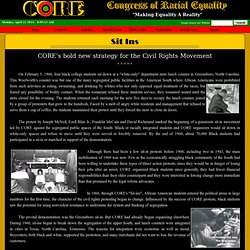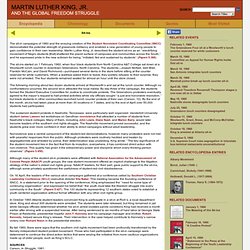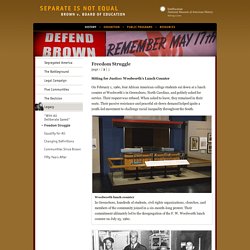

THE WOOLWORTH SIT. Our Woolworth Sit-In, Jackson Mississippi, 5/28/63 was the most violently attacked sit-in of the '60s and the most publicized.

Involving a White mob of several hundred, it went on for several hours while hostile police from Jackson's huge all-White police department stood by approvingly outside and while hostile FBI agents inside (in sun-glasses) "observed. " Seated, left to right are Hunter Gray (John R. Salter, Jr.) -- Native American; Joan Trumpauer (now Mulholland), a White Southern student at our private Black college, Tougaloo College [one of two White students at Tougaloo]; Anne Moody, Black, from Wilkinson County, Mississippi.
I, Gray [Salter] was a very young Tougaloo professor; and Joan and Anne were my students. Civil Rights Movement 1955-1965: Sit-Ins. [Previous Topic] [Next Topic] [Up] [Table of Contents] [Citation Guide] [Feedback] [Search] [Home] [Help!]

"All of Africa will be free before we can get a lousy cup of coffee. "-- James Baldwin[16] On February 1, 1960, Joseph McNeil, Franklin McCain, David Richmond, and Ezell Blair, Jr., walked into an F.W. Woolworth Company store in Greensboro, North Carolina, purchased some school supplies, then went to the lunch counter and asked to be served. They knew they probably would not be. The four freshmen at the North Carolina Agricultural and Technical College were black, and this lunch counter was segregated. This first sit-in had very little effect. The basic plan of the sit-ins was that a group of students would go to a lunch counter and ask to be served.
Do show yourself friendly on the counter at all times. Another part of the sit-ins was that the students would be dressed up in their best Sunday clothing. The first few weeks of sit-ins were fairly quiet. On April 19, Z. Sit Ins. On February 5, 1960, four black college students sat down at a "white-only" department store lunch counter in Greensboro, North Carolina.

This Woolworth's counter was but one of the many segregated public facilities in the American South where African Americans were prohibited from such activities as eating, swimming, and drinking by whites who not only opposed equal treatment of the races, but feared any possibility of bodily contact. When the restaurant refused these students service, they remained seated until the store closed for the evening. The students returned each morning for the next five days to occupy the lunch counter, joined by a group of protesters that grew to the hundreds. Faced by a mob of angry white residents and management that refused to serve them a cup of coffee, the students maintained their protest until they forced the store to close its doors. Rules of the Sit-In. The young black men desiring change, dressed in their best clothes and brought books to study as they waited.

There were a set of rules they were to follow, the set of rules were one's that negated violence and were there to insure the safety of all participants and whites in those same areas. The rules are listed below, and all those unwilling to follow would not be included: Do show yourself friendly on the counter at all times.Do sit straight and always face the counter.Don't strike back, or curse back if attacked.Don't laugh out.Don't hold conversations.Don't block entrances. They had splended attitudes and were unwilling to break that goodness for anyone. If the whites didn't like them there, it was for no other reason than their color. "When you go somewhere looking for trouble, you usually find it. " - John Patterson, Govenor of Alabama Sit-ins. The sit-in campaigns of 1960 and the ensuing creation of the Student Nonviolent Coordinating Committee (SNCC) demonstrated the potential strength of grassroots militancy and enabled a new generation of young people to gain confidence in their own leadership.

Martin Luther King, Jr. described the student sit-ins as an ‘‘electrifying movement of Negro students [that] shattered the placid surface of campuses and communities across the South,’’ and he expressed pride in the new activism for being ‘‘initiated, fed and sustained by students’’ (Papers 5:368). The sit-ins started on 1 February 1960, when four black students from North Carolina A&T College sat down at a Woolworth lunch counter in downtown Greensboro, North Carolina. The students—Joseph McNeil, Izell Blair, Franklin McCain, and David Richmond—purchased several items in the store before sitting at the counter reserved for white customers.
Woolworth's Lunch Counter - Separate Is Not Equal. Sitting for Justice: Woolworth’s Lunch Counter On February 1, 1960, four African American college students sat down at a lunch counter at Woolworth’s in Greensboro, North Carolina, and politely asked for service.

Their request was refused. When asked to leave, they remained in their seats. Their passive resistance and peaceful sit-down demand helped ignite a youth-led movement to challenge racial inequality throughout the South.